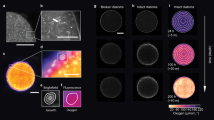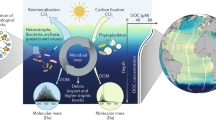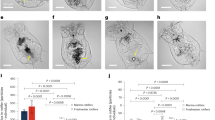Abstract
A large pool of organic carbon resides in the world's oceans in the form of dissolved organic matter (DOM)1,2. DOM is operationally defined as the fraction of organic matter that passes through a filter with a given pore size (which can range from less than 0.1 μm to 0.46 μm). This fraction has a longer oceanic residence time — and is generally less biodegradable — than particulate organic matter (POM)1,2,3,4. Processes transforming DOM into POM are therefore crucial for our understanding of the cycling of organic material in the oceans1,2,3,4. The aggregation of marine colloids, which constitute 10–40% of DOM2,3,5, is thought to be an important step in the transformation of DOM into POM3. It has been suggested that colloids, as well as transparent exopolymer particles and large aggregates (‘marine snow’) can be viewed as polymer gels6,7,8. Whether free DOM polymers can indeed spontaneously assemble to form polymer gels has, however, not yet been shown. Here we present experimental observations that demonstrate that marine polymer gels can assemble from free DOM polymers, and that their formation mechanism, physical characteristics and mineralization can be understood in terms of polymer gel theory9,10,11. The principles and methods of polymer gel physics thus have the potential to provide profound new insights into the processes controlling the exchange between the DOM and POM pools and the cycling of marine organic matter.
This is a preview of subscription content, access via your institution
Access options
Subscribe to this journal
Receive 51 print issues and online access
$199.00 per year
only $3.90 per issue
Buy this article
- Purchase on Springer Link
- Instant access to full article PDF
Prices may be subject to local taxes which are calculated during checkout




Similar content being viewed by others
References
Hedges, J. I. Global biogeochemical cycles: progress and problems. Mar. Chem. 39, 67–93 (1992).
Guo, L. & Santschi, P. H. Composition and cycling of colloids in marine environments. Rev. Geophys. 35, 17–40 (1997).
Kepkay, P. E. Particle aggregation and the biological reactivity of colloids. Mar. Ecol. Prog. Ser. 109, 293–304 (1994).
Amon, R. M. W. & Benner, R. Bacterial utilization of different size classes of dissolved organic matter. Limnol. Oceanogr. 41, 41–51 (1996).
Wells, M. L. & Goldberg, E. D. The distribution of colloids in the North Atlantic and Southern Oceans. Limnol. Oceanogr. 39, 286–302 (1994).
Cowen, J. P. & Holloway, C. F. Structural and chemical analysis of marine aggregates: in situ macrophotography and laser confocal and electron microscopy. Mar. Biol. 126, 163–174 (1996).
Alldredge, A. L., Passow, U. & Logan, E. B. The abundance and significance of a class of large, transparent organic particles in the oceans. Deep-Sea Res. 40, 1131–1140 (1993).
Benedetti, M. F., Van Riemsdijk, W. H. & Koopal, L. K. Humic substances considered as a heterogenous Donnan gel phase. Environ. Sci. Techol. 30, 1805–1813 (1996).
de Gennes, P. G. & Leger, L. Dynamics of entangled polymer chains. Annu. Rev. Phys. Chem. 33, 49–61 (1982).
Edwards, S. F. The theory of macromolecular networks. Biorheology 23, 589–603 (1986).
Li, Y. & Tanaka, T. Phase transitions of gels. Annu. Rev. Mater. Sci. 22, 243–277 (1992).
Stordal, M. C., Santschi, P. H. & Gill, G. A. Colloidal pumping: evidence for the coagulation process using natural colloids tagged with 230Hg. Environ. Sci. Technol. 30, 3335–3340 (1996).
Verdugo, P. Polymer gel phase transition in condension-decondensation of secretory products. Adv. Polym. Sci. 110, 145–156 (1994).
Aluwihare, L. I., Repeta, D. J. & Chen, R. F. Amajor biopolymeric component to dissolved organic carbon in surface sea water. Nature 387, 166–169 (1997).
Caswell, A. H. & Hutchison, J. D. Visualization of membrane bound cations by a fluorescent technique. Biochem. Biophys. Res. Commun. 42, 43–49 (1971).
Katchalsky, A., Lifson, S. & Eisenberg, H. J. Equation of swelling for polyelectrolyte gels. J. Polym. Sci. 7, 571–574 (1951).
Tam, P. Y. & Verdugo, P. Control of mucus hydration as a Donnan equilibrium process. Nature 292, 340–342 (1981).
Crenshaw, M. A. in Biological Mineralization and Demineralization (ed. Nancollas, G. H.) 243–257 (Springer, Berlin, 1982).
Verdugo, P., Orellana, M. V. & Freitag, C. The secretory granule as a biomimetic model for drug delivery. Proc. 22nd Int. Symp. on Controlled Release of Bioactive Materials 22, 25 (1995).
Marsh, M. E. Polyanion-mediated mineralization-assembly and reorganization of acidic polysaccharides in the Golgi system of a cocolithphorid algal during mineral deposition. Protoplasma 177, 108–122 (1994).
Addadi, L., Moradian, J., Shay, E., Maraudas, N. G. & Weiner, S. Achemical model for the cooperation of sulfates and carboxylates in calcite crystal nucleation: relevance to biomineralization. Proc. Natl. Acad. Sci. USA 84, 2732–2736 (1987).
Lubbers, G. W., Gieskes, W. W. C., del Castilho, P., Salomons, W. & Bril, J. Manganese accumulation in the high pH microenvironment of Phaeocystis sp. (Haptophyceae) colonies from the North Sea. Mar. Ecol. Prog. Ser. 59, 285–293 (1990).
Morse, J. W. & Mackenzie, F. T. Geochemistry of Sedimentary Carbonates (Elsevier, Amsterdam, 1990).
Orellana, M. V. & Perry, M. J. An immunoprobe to measure Rubisco concentrations and maximal photosynthetic rates of individual phytoplankton cells. Limnol. Oceanogr. 37, 478–490 (1992).
Benner, R., Pakulski, J. D., McCarthy, M., Hedges, J. I. & Hatcher, P. G. Bulk chemical characteristics of dissolved organic matter in the ocean. Science 255, 1561–1564 (1992).
Mayer, L. M. Surface area control of organic carbon accumulation in continental shelf sediments. Geochim. Cosmochim. Acta 58, 1271–1284 (1994).
Nishikawa, T., Akiyoshi, K. & Sunamoto, J. Supramolecular assembly between nanoparticles of hydrophobized olysaccharide and soluble protein complexation between the self-aggregate of cholesterol-bearing pullalan and α-chymotrypsin. Macromolecules 27, 7654–7659 (1994).
Largeau, C. in Role of Nonliving Organic Matter in the Earth's Carbon Cycle (eds Zepp, R. G. & Sonntag, C.) 275–292 (Wiley, New York, 1995).
Kieber, R. J., Zhou, X. & Mopper, K. Formation of carbonyl compounds from UV-induced photodegradation of humic substances in natural waters; fate of riverine carbon in the sea. Limnol. Oceanogr. 35, 1503–1515 (1990).
Provencher, S. W. Aconstrained regularization method for inverting data represented by linear algebraic or integral equations. Comput. Phys. Commun. 27, 213–227 (1982).
Acknowledgements
We thank M. J. Perry, P. Jumars and J. Hedges for their comments and suggestions. This work was supported by the US NSF (Polar Program) and the Royalty Research Fund (University of Washington).
Author information
Authors and Affiliations
Rights and permissions
About this article
Cite this article
Chin, WC., Orellana, M. & Verdugo, P. Spontaneous assembly of marine dissolved organic matter into polymer gels. Nature 391, 568–572 (1998). https://doi.org/10.1038/35345
Received:
Accepted:
Issue Date:
DOI: https://doi.org/10.1038/35345
This article is cited by
-
Authigenic clays as precursors to carbonate precipitation in saline lakes of Salar de Llamara, Northern Chile
Communications Earth & Environment (2022)
-
Glycoside hydrolase from the GH76 family indicates that marine Salegentibacter sp. Hel_I_6 consumes alpha-mannan from fungi
The ISME Journal (2022)
-
Diatom fucan polysaccharide precipitates carbon during algal blooms
Nature Communications (2021)
-
Environmental influence on transparent exopolymer particles and the associated carbon distribution across northern South China Sea
Journal of Oceanology and Limnology (2021)
-
Assessing the Temporal Variability and Drivers of Transparent Exopolymer Particle Concentrations and Production Rates in a Subtropical Estuary
Estuaries and Coasts (2021)
Comments
By submitting a comment you agree to abide by our Terms and Community Guidelines. If you find something abusive or that does not comply with our terms or guidelines please flag it as inappropriate.



